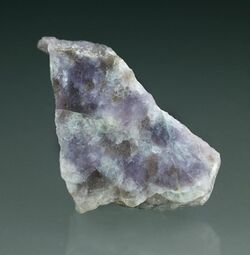Chemistry:Rubicline
| Rubicline | |
|---|---|
 | |
| General | |
| Category | Feldspar group |
| Formula (repeating unit) | (Rb, K)[AlSi3O8] |
| Strunz classification | 9.FA.30 |
| Crystal system | Triclinic |
| Crystal class | Pinacoidal (1) (same H-M symbol) |
| Space group | P1 |
| Identification | |
| Formula mass | 313.11 g/mol |
| Color | Colorless |
| Cleavage | {001} |
| |re|er}} | Vitreous |
| Diaphaneity | Transparent |
| Density | 2.8 g/cm3 |
| Optical properties | biaxial |
| Refractive index | nα = 1.520 nβ = 1.524 nγ = 1.527 |
| Birefringence | δ = 0.007 |
| Dispersion | Strong |
| Other characteristics | Radioactive |
| References | [1][2] |
Rubicline, also referred to as Rb-microcline, is the rubidium analogue of microcline, an important tectosilicate mineral. Its chemical formula is (Rb, K)[AlSi3O8] with an ideal composition of RbAlSi3O8. Chemical analysis by electron microprobe indicated the average weight of the crystal is 56.66% SiO2, 16.95% Al2O3, and 23.77% Rb2O,[4] along with trace amounts of caesium oxide (Cs2O) and iron(III) oxide (Fe2O3).[5]
Rubicline was first discovered in 1998 in Elba, Italy, by a team from the University of Manitoba. It was the first mineral to have been discovered with rubidium as an essential constituent.[5] It has also been found in Mozambique[6] and the Kola Peninsula in Russia .[7] Rubicline occurs as small, abundant, rounded grains found within veins of rubidian microcline. Pure rubicline with an ideal potassium-free composition has never been found in nature.[4] Rubicline was synthesized in 2001 by placing powdered albite in a solvent of RbCl. This mixture was then placed in a silver tube containing H2O, heated to 400 °C and pressurized to 60 MPa.[4]
Unlike microcline, which can be yellow, red, or green, rubicline is colorless. It is also transparent, brittle,[5] and has a vitreous luster.[8] Rubicline has been classified as both triclinic and monoclinic.[4][8] The crystal does not show twinning. Other minerals in this group include adularia, anorthoclase, buddingtonite, celsian, hyalophane, microcline, monalbite, orthoclase, and sanidine.[8]
Like all rubidium compounds, rubicline is mildly radioactive. Activity and dose rate of various amounts of rubicline are listed in the table below.[1]
| Specimen weight/size | Calculated activity (Bq) |
Calculated activity (Ci) |
Estimated activity GR(api) |
Estimated exposure (mRem)/hr* |
|---|---|---|---|---|
| 1000 g / 8.79 cm | 183,355 | 4.96×10−6 | 8,449.31 | 2.78 |
| 100 g / 4.08 cm | 18,336 | 4.96×10−7 | 844.93 | 0.28 |
| 10 g / 1.89 cm | 1,834 | 4.96×10−8 | 84.49 | 0.03 |
| 1 g / 8.79 mm | 183 | 4.96×10−9 | 8.45 | 0.00 |
| 0.1 g / 4.08 mm | 18 | 4.96×10−10 | 0.84 | 0.00 |
| 0.01 g / 1.89 mm | 2 | 4.96×10−11 | 0.08 | 0.00 |
| 0.001 g / 0.88 mm | 0 | 4.96×10−12 | 0.01 | 0.00 |
- If held in hand for one hour.
- Government estimate of average annual exposure (360 mRem)
- Max permissible adult dose 50,000 mRem/yr (hands), 15,000 mRem/yr (eyes)
- Lethal exposure 400,000 to 500,000 mRem
References
- ↑ 1.0 1.1 Rubicline at Webminerals
- ↑ Rubicline at Mindat
- ↑ Warr, L.N. (2021). "IMA–CNMNC approved mineral symbols". Mineralogical Magazine 85 (3): 291–320. doi:10.1180/mgm.2021.43. Bibcode: 2021MinM...85..291W.
- ↑ 4.0 4.1 4.2 4.3 Kyono, A.; Kimata, M. (August 2001). "Refinement of the crystal structure of a synthetic non-stoichiometric Rb-feldspar". Mineralogical Magazine 65 (4): 523–531. doi:10.1180/002646101750377542. Bibcode: 2001MinM...65..523K. http://rruff.info/uploads/MM65_523.pdf.
- ↑ 5.0 5.1 5.2 Teertstra, David K. (December 2008). "Rubicline, a new feldspar from San Piero in Campo, Elba, Italy". American Mineralogist 83 (11–12): 1335–1339. doi:10.2138/am-1998-11-1223. http://ammin.geoscienceworld.org/cgi/content/abstract/83/11-12_Part_1/1335.
- ↑ Teertstra, D. K.; Cerny, P.; Hawthorne, F. C. (1999). "Subsolidus rubidium-dominant feldspar from the Morrua pegmatite, Mozambique: paragenesis and composition". Mineralogical Magazine 63 (3): 313–320. doi:10.1180/002646199548538. ISSN 0026-461X. Bibcode: 1999MinM...63..313T.
- ↑ "Rubicline R070044". RRUFF. http://rruff.info/rubicline/names/asc/. Retrieved 15 February 2010.
- ↑ 8.0 8.1 8.2 "Rubicline". Mindat.org. 2010. http://www.mindat.org/min-7276.html. Retrieved 15 February 2010.
 |

